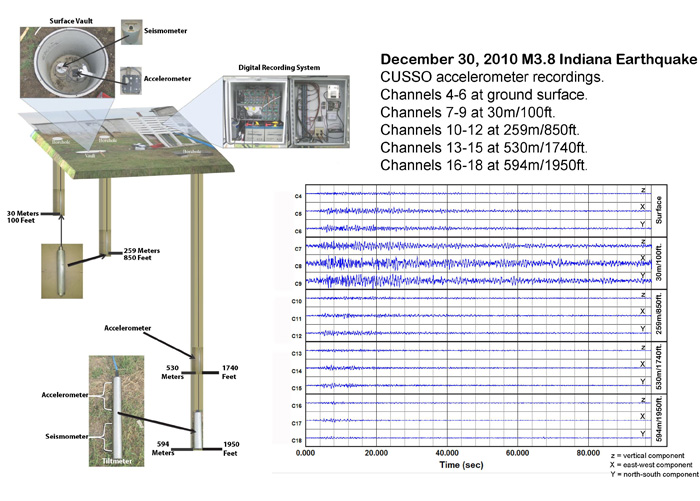

KGS Home > News and Announcements
Deep Seismic Observatory now Operational in Western Kentucky
Lexington, Ky. (January 7, 2011)—A new array of seismic instruments installed in a deep hole in rural Fulton County, Kentucky is now operational and providing valuable data on earthquake activity in the central U.S. The instruments have been installed in a four-inch diameter, steel-cased borehole which was drilled 1,950 feet deep to bedrock at Sassafras Ridge in western Fulton County by the Kentucky Geological Survey (KGS), a research center of the University of Kentucky. The new vertical array is dubbed the Central U. S. Seismic Observatory (CUSSO) and joins the 25 other seismic monitoring stations in the Kentucky Seismic and Strong-Motion Network (KSSMN) operated by the Kentucky Geological Survey. CUSSO is the deepest seismic observatory in the eastern half of the U.S.
Drilling of the borehole was completed late in 2006. KGS and its partners then applied for funding to build and install the instruments. When funding was secured, seismic instruments were built by EENTEC of St. Louis and VLF Designs of Jackson, Missouri, for the observatory. Three-component accelerometers, which detect strong ground motions, are situated 1680 feet and 1948 feet deep in the borehole, while a seismometer measuring medium-period motions at 1949 feet, and an inclinometer was placed at the bottom. At the surface, an additional seismometer and accelerometer are housed in a vault. A digital recording system and wireless internet connection are also at the site to gather and send data to KGS scientists in Lexington. Two other shallower holes containing seismic instruments were already located at the site.
“This observatory will gather information from earthquake waves in the New Madrid Seismic Zone and other active zones in the Midwest as they propagate to the surface,” says KGS Director and State Geologist Jim Cobb. “In some cases the ground shaking intensifies as the waves move upward through unconsolidated sedimentary layers typical of western Kentucky geology.”
The location of the observatory is near the center of the New Madrid Seismic Zone that was the source of several very strong earthquakes in 1811 and 1812, shaking the eastern half of the U. S. and parts of Canada. This location, only a few miles from New Madrid, Missouri, is a good one to collect the maximum amount of data from the New Madrid Seismic Zone.
“Data collected will help geologists and engineers better define the earthquake hazard in the region,” according to KGS geologist Dr. Zhenming Wang, who coordinated the development of CUSSO with Professor Ed Woolery of the UK Department of Earth and Environmental Sciences. “Finding out more about the nature of the earthquake hazard will have an important effect on economic development in the region, because data collected by the observatory will be used to insure that building codes and construction practices are appropriate for mitigating potential earthquake damages in the region.”
The five partners involved in the project have committed a total of $295,652 with a substantial amount of the funding coming from the United States Department of Energy through the Kentucky Research Consortium for Energy and the Environment.
The partners on the project include:

The Central U. S. Seismic Observatory in western Kentucky includes a number of earthquake-sensing instruments
and the capability to record and transmit information to the Kentucky Geological Survey.
It recorded ground shaking from the small Dec. 30, 2010 Indiana earthquake at multiple depths.